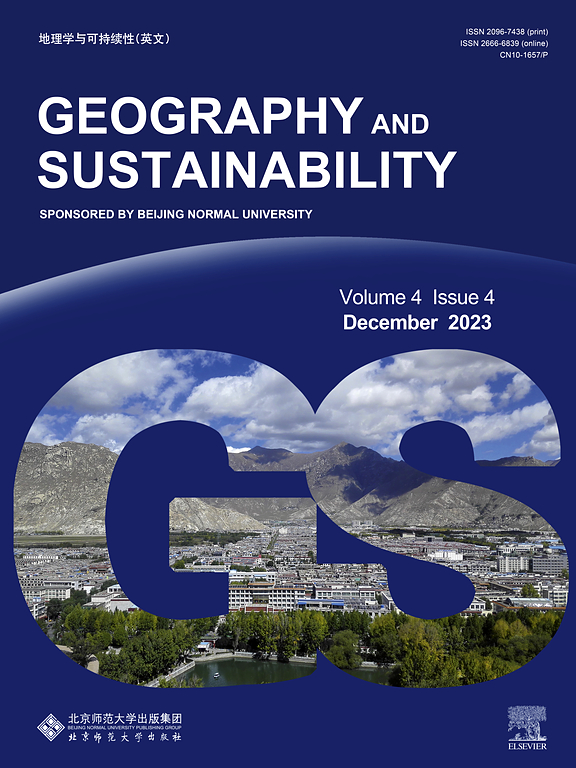探索地中海山区土地撂荒后的最佳管理,增强其长期碳储量
IF 8
1区 环境科学与生态学
Q1 GEOGRAPHY, PHYSICAL
引用次数: 0
摘要
地中海中部山区农村活动的放弃导致了植被恢复过程的启动,以及随后实施的各种管理措施,以减轻相关的生态系统损害。鉴于土壤环境及其在气候变化背景下日益重要的意义,研究土地管理和景观变化如何影响土壤碳储存过程及其动态变化具有重要意义。在拉里奥哈(西班牙伊比利亚系统)进行了一项研究,比较了三种撂荒后管理策略:次生演替、森林管理、灌木清除和广泛放牧。在两种类型的土壤环境(酸性和碱性)和两个深度范围(0-20 cm和20-40 cm)下分析了这些策略。对三种团聚体粒径(<;2mm, 2 - 5 mm, >;5毫米)和三个密度分数(自由不稳定,闭塞和重分数)。结果表明:1)团聚体中有机碳含量;在酸性环境中,灌木清除和放牧方式增加了2 mm(相对于总有机碳);2)在酸性环境下实施植树造林和在碱性环境下实施三种研究策略均有利于总体稳定性;3)在酸性环境下,造林地土壤有机碳(游离和封闭)含量显著高于灌丛地,而在碱性环境下,灌丛空地土壤有机碳含量显著高于灌丛地。因此,地中海山区土地弃置后的土地管理应注重有机碳的储存。本文章由计算机程序翻译,如有差异,请以英文原文为准。

Searching for the best post-land abandonment management to enhance long-term carbon storage in Mediterranean mountain areas
The abandonment of rural activities in the Mediterranean mid-mountains has led to the activation of revegetation processes, as well as the subsequent implementation of various management measures to mitigate the associated ecosystem disservices. Focusing on soil environment and its growing importance in a climate change scenario, it is of great interest to study how land management and landscape changes can affect, not only the soil carbon storage process, but also its dynamics. A study was conducted in La Rioja (Iberian System, Spain), comparing three post-abandonment management strategies: secondary succession, forest management, and shrub clearing and extensive grazing. These strategies were analysed in two types of soil environments (acid and alkaline) and for two depth ranges (0–20 cm and 20–40 cm). Laboratory analyses were performed on aggregate stability and soil organic carbon fractionation with regard to three aggregate sizes (< 2 mm, 2–5 mm, > 5 mm) and three density fractions (free labile, occluded, and heavy fraction). The results showed that: 1) SOC content in aggregates < 2 mm (relative to total SOC) increases with shrub clearing and grazing strategy in acid environments; 2) aggregate stability benefits from the implementation of afforestation in acid environments and from all three study strategies in alkaline ones; 3) in acid environments, the percentage of labile fractions (free and occluded) in afforested sites is significantly higher compared with shrubland, while in alkaline environments, recalcitrant SOC is significantly higher in shrub clearing sites. Thus, land management should be focused on SOC storage after land abandonment in Mediterranean mountainous environments.
求助全文
通过发布文献求助,成功后即可免费获取论文全文。
去求助
来源期刊

Geography and Sustainability
Social Sciences-Geography, Planning and Development
CiteScore
16.70
自引率
3.10%
发文量
32
审稿时长
41 days
期刊介绍:
Geography and Sustainability serves as a central hub for interdisciplinary research and education aimed at promoting sustainable development from an integrated geography perspective. By bridging natural and human sciences, the journal fosters broader analysis and innovative thinking on global and regional sustainability issues.
Geography and Sustainability welcomes original, high-quality research articles, review articles, short communications, technical comments, perspective articles and editorials on the following themes:
Geographical Processes: Interactions with and between water, soil, atmosphere and the biosphere and their spatio-temporal variations;
Human-Environmental Systems: Interactions between humans and the environment, resilience of socio-ecological systems and vulnerability;
Ecosystem Services and Human Wellbeing: Ecosystem structure, processes, services and their linkages with human wellbeing;
Sustainable Development: Theory, practice and critical challenges in sustainable development.
 求助内容:
求助内容: 应助结果提醒方式:
应助结果提醒方式:


